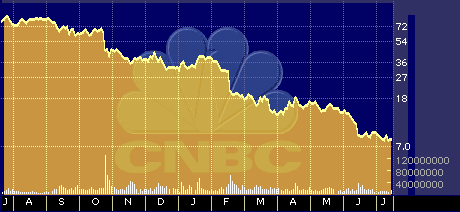
InterWAVE IPO Shines as Expected
InterWAVE IPO Shines as Expected
by Hal Plotkin
Silicon Valley Correspondent
Analysts expected a strong debut by interWAVE Communications International Ltd. {IWAV} when its stock began trading on Friday.
“I think it’s going to be a hot IPO with a steadily increasing stock price,” says Hongjun Li, director of research at Parks Associates in New York. “I know I would certainly buy the stock.”
It looks like investors agreed.
Shares of interWAVE closed on Friday near $37, well above its initial price of $13 a share. The company offered 8.5 million shares to the public.
Bermuda-based interWAVE makes compact wireless-communications systems based on an international technical standard called GSM. Nortel Networks Corp. {NT} is the company’s largest shareholder, with a 24 percent stake.

Nortel Networks 52-Week Stock-Performance Chart
“The relationship between interWAVE and Nortel helps both companies,” Li says. “Nortel seemed out of touch with the market two years ago. But they are catching up quickly. InterWAVE gives them competitive tools they need in order to overtake companies like Motorola {MOT} and Ericsson {ERICY}.”
Andrew Seybold, publisher of Outlook, a prominent wireless-industry trade journal, also expects interWAVE to make a successful market debut.
“These days, anything that uses the word ‘wireless’ gets caught up in Wall Street’s feeding frenzy,” Seybold says.
Seybold’s optimism about the company’s IPO isn’t, however, matched with equal measures of enthusiasm about the company itself. “I’d say they have an interesting but not compelling concept, particularly here in the U.S.” he says.
The company’s GSM wireless technology is being eclipsed in the United States, Seybold notes, by two other relatively more-robust formats, CDMA and TDMA.
“GSM is not the pervasive technology in the United States,” Seybold says. “There are projections of it falling to less than 10 percent in a few years.” The competing wireless formats offer several increasingly critical features, he says, such as better security and higher data-transmission rates.
The GSM format is, however, thriving in the rest of the world, accounting for more than 500 million customers, or about 60 percent to 65 percent of the global wireless market in 1999, according to Li. “There is no doubt that GSM is the most widely deployed standard in the world,” he says.
One key to interWAVE’s strategy involves selling compact GSM wireless units that companies can use to replace internal hard-wired telecommunications networks.
The company also sells its boxes to wireless-network service providers to provide telephone service in previously unserved areas. It has sold more than 1,000 units which have been installed in 17 different countries since the firm’s inception in 1997.
“They have a comprehensive solution in a box,” Li says. “You don’t need a number of suppliers, and it’s more cost-effective than similar cellular-based technologies.”
Seybold agrees that cost savings and ease-of-installation features are advantages for the company and adds that privately owned wireless networks are already common outside the U.S.
“In Europe, where GSM is king, there is already that kind of thing going on,” Seybold says. “At Ericsson’s headquarters, for example, employees are hooked into the wireless system whenever they come into the building. That’s why [interWAVE’s] real viability is in Europe and Asia, especially if they have gotten the cost down.”
Seybold says it is unlikely telecom customers in the U.S. will be rushing to rip out hard-wired networks in order to install new wireless systems. “But if you don’t already have a system, in place it becomes more interesting,” he says.
The company faces considerable competition from other GSM communications-equipment suppliers, including Ericsson, Lucent Technologies Inc. {LU} Motorola Inc., Nokia Corp. {NOK} and Siemens AG {SMAWY}. It also competes in application areas with two of its largest customers, Alcatel and Nortel.
“All of the major GSM communications-equipment providers have broad product lines that include at least partial GSM solutions that address our target markets,” interWAVE warns in its F-1, the foreign firm’s official pre-IPO filing with the Securities and Exchange Commission.
“There’s room for GSM in the market,” Seybold says. “Moving forward, it’s a major player in Europe.”
Li is more optimistic. “I don’t think the other standards are going to disappear,” he says. “But I do think what you will eventually get are handsets that work with all three formats. Then the format won’t matter. In that case, interWAVEs technology will remain a good choice for many customers, particularly those motivated by cost savings.”
The company posted a loss of $8.9 million on revenue of $5.3 million for the fiscal first quarter ended Sept. 30, as compared with a loss of $5 million on revenue of $4.5 million for the same period a year earlier.
All told, just four customers, including Nortel, accounted for 82 percent of interWAVE sales during the most recent quarter on record.


